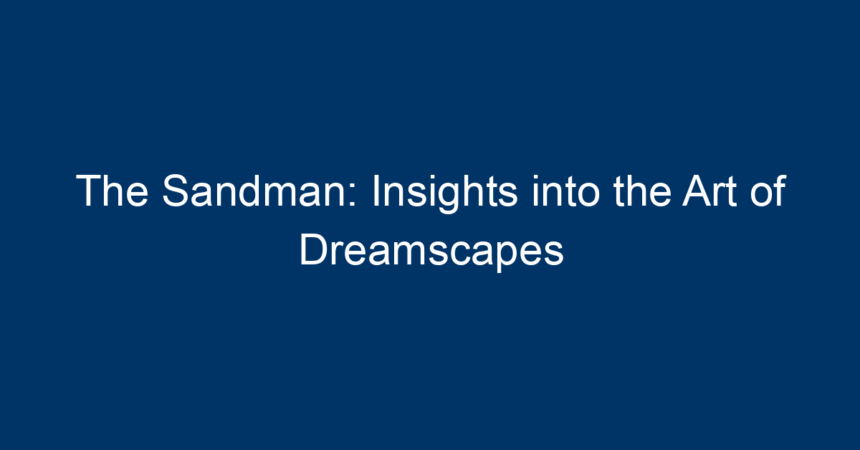The realm of dreams has long intrigued humanity, weaving complex narratives that blur the line between reality and fantasy. Neil Gaiman’s The Sandman, a groundbreaking graphic novel series, dives deep into this captivating world of dreamscapes, blending mythology, horror, and philosophy. This article unpacks the artistic elements of The Sandman, exploring themes, characters, and Gaiman’s unique storytelling techniques that have made the series a staple of modern literature.
Understanding the Dream World of The Sandman
The Concept of Dreamscapes
Dreamscapes, as depicted in The Sandman, are not just fantastical landscapes; they are rich in symbolism and emotional resonance. Gaiman crafts a universe where dreams serve as a reflection of human consciousness, fears, and desires. Each dreamscape is meticulously designed to evoke specific emotions and illustrate the depths of the human psyche.
-
Symbolism in Dreams: Gaiman employs symbols to create dreamscapes that resonate with readers. An example is the realm of dreams that often features surreal imagery, such as fluid landscapes that defy the laws of physics. This symbolizes the fluidity of human thought and imagination.
- Emotional Layering: Each character’s dream reflects their inner turmoil or aspirations. For instance, Morpheus (Dream) himself embodies the complexity of dreams—he is ethereal yet grounded, indicating the interconnectedness of dreams with reality.
The Role of Morpheus: The Dream King
At the heart of The Sandman is Morpheus, the central character who governs the realm of dreams. His portrayal challenges conventional notions of character and morality, making him an intriguing figure.
-
Hero or Anti-Hero?: Morpheus is not a typical hero; his actions often stem from a rigid adherence to duty rather than empathy. This complexity adds depth to his character and challenges readers to reconsider traditional archetypes.
- Evolution Throughout the Series: As the narrative progresses, we witness Morpheus’s evolution. His relationships with humans and other Endless beings shape his arc, making his journey one of self-discovery and redemption.
Artistic Techniques in The Sandman
Visual Storytelling
The artistry of The Sandman plays a pivotal role in its narrative success. Each artist who has illustrated the series—primarily Sam Kieth, Mike Dringenberg, and Dave McKean—brings unique styles that enrich the dreamscapes.
-
Diverse Artistic Styles: The varying artistic approaches create a diverse visual language that complements the storytelling. For instance, McKean’s mixed-media covers juxtapose photography and painting, embodying the dream-like qualities of the narrative.
- Atmospheric Tone: The artwork’s atmospheric qualities evoke moods that are critical to the storytelling. Dark, shadowy panels capture the essence of nightmares, while softer, lighter illustrations symbolize peace and escape.
Typography and Layout
In addition to visuals, the use of typography and layout enhances the reading experience. Gaiman employs creative typography that mirrors the tone of the narrative.
-
Dialogue and Narration: Different fonts denote dialogue, inner thoughts, and narration, guiding the reader’s interpretation. This playful use adds a layer of depth to the reading experience, reflecting the complexity of the characters’ emotions.
- Panel Design: The arrangement of panels can reflect the pace and flow of the narrative. Stretching panels can create a sense of time and space, allowing readers to immerse themselves in the dream world.
Themes Explored in The Sandman
The Nature of Dreams and Reality
One of the central themes in The Sandman is the intricate relationship between dreams and reality. Gaiman invites readers to explore how dreams influence waking life and vice versa.
-
Exploration of Identity: The series delves into how dreams shape identity. For instance, characters often confront their desires and fears within their dreamscapes, leading to profound realizations that inform their waking lives.
- The Power of Storytelling: Gaiman suggests that storytelling—both in dreams and reality—holds transformative power. Characters in The Sandman often find solace or confront their demons through the stories they tell and experience.
Life, Death, and the Unending Cycle
The theme of mortality is ever-present in The Sandman, explored through the relationship between the Endless, particularly Morpheus and his siblings.
-
Understanding Death: Death, personified as an upbeat character in the series, counters typical portrayals of death as somber or fear-inducing. This offers readers a more compassionate view of mortality, encouraging acceptance over fear.
- Cycle of Life: Gaiman eloquently illustrates the cycle of life, death, and rebirth throughout the series. The characters’ journeys underscore the understanding that death is a natural part of existence, often leading to renewal and transformation.
Cultural Impact of The Sandman
A Influence on Popular Culture
The Sandman has left an indelible mark on popular culture, influencing countless works across various media. Its impact is evident in literature, film, and television.
-
Graphic Novels and Beyond: The series helped elevate graphic novels as a legitimate art form. It paved the way for future creators to explore complex themes and narratives traditionally reserved for prose.
- Adaptations and Spin-offs: The rich tapestry of The Sandman has spawned adaptations, including audiobooks and a recent Netflix series. These adaptations bring Gaiman’s vision to new audiences while expanding the lore of the universe.
Conclusion: Embracing the Dreamscapes
The Sandman is not merely a story about dreams; it serves as a profound exploration of human nature, identity, and the power of imagination. Through its rich narratives, layered characters, and stunning artistry, the series invites readers to reflect on their own dreams and the world around them.
Actionable Insights
-
Reflect on Your Dreams: Take time to journal about your dreams. What emotions do they evoke? What do they reveal about your subconscious desires or fears?
-
Explore Graphic Literature: Dive into other graphic novels that explore similar themes, such as Y: The Last Man or Saga. Engaging with diverse narratives can enhance your understanding of storytelling.
-
Create Your Own Dreamscapes: Inspired by Gaiman’s artistic approach, consider creating a visual representation of your dreams. This can be through drawing, painting, or digital art, allowing for personal expression.
- Engage with the Community: Join online forums or book clubs focused on The Sandman and similar literature. Engaging in discussions can deepen your appreciation and understanding of the themes explored.
By immersing yourself in the dreamscapes of The Sandman, you not only appreciate Gaiman’s artistry but also unlock a deeper understanding of your own consciousness and creativity.




